Following the departure of Julian Nagelsmann to RB Leipzig, Hoffenheim have identified Alfred Schreuder as the man to fill his shoes. The Dutch coach arrives in challenging circumstances, with talismanic players Kerem Demirbay and Joelinton also leaving the Rhein-Neckar-Arena over the summer. However, there have been some impressive additions to the squad that should boost his chances of success.
One of the most exciting acquisitions, Robert Skov has signed from FC Copenhagen for a reported 9 million euros. The 23-year-old impressed greatly during his time in the Danish Superliga, breaking the record for most goals scored in a single campaign.
This tactical analysis scout report will highlight his most valuable attributes and examine how he might fit into Schreuder’s plans.
Positioning and movement
Skov has spent most of the early parts of his career occupying an inside right position, both for club and country. Although only managing to earn one full international cap so far, he has been a crucial player for Denmark’s under-21 side.
His preference is to support the attack from the advanced right half-space, allowing his fullback to make overlapping runs on the outside. From this starting point, he can also look to make penetrative passes in central areas or combine with his teammates to create a shooting opportunity. As we will see later in this analysis, Skov can be devastating when given space to strike from range.
The image below illustrates his standard positioning, with right-back Rasmus Kristensen making an overlapping run on the wing. On this occasion, Skov waits for the opposing fullback to follow Kristensen, before dribbling into the vacated space and forcing a save at the near post.
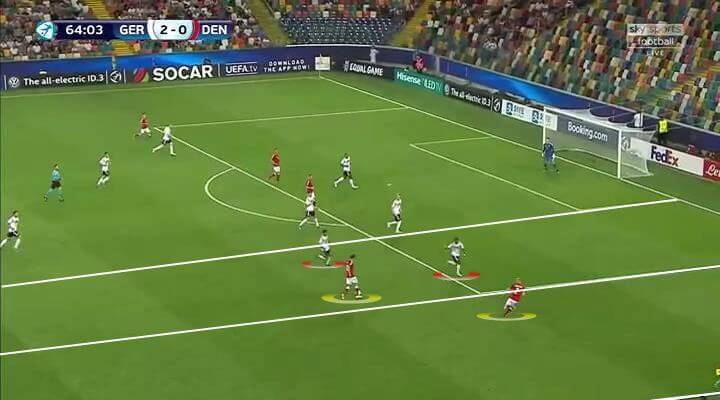
When space exists in the wide channel, Skov is also capable of arriving to receive on the blind-side of the opponent’s left-back. Oftentimes, the defender will move up to close down the ball-occupant, leaving space to exploit behind him. Alternatively, he might choose to focus on blocking off a pass into central areas, with the same consequences.
The next image shows an example of this scenario, with the Randers fullback covering the pass into Skov’s feet. The dynamic attacker moves to receive in the space down the wing, before dribbling towards goal and executing a cut-back for a teammate on the edge of the penalty area.
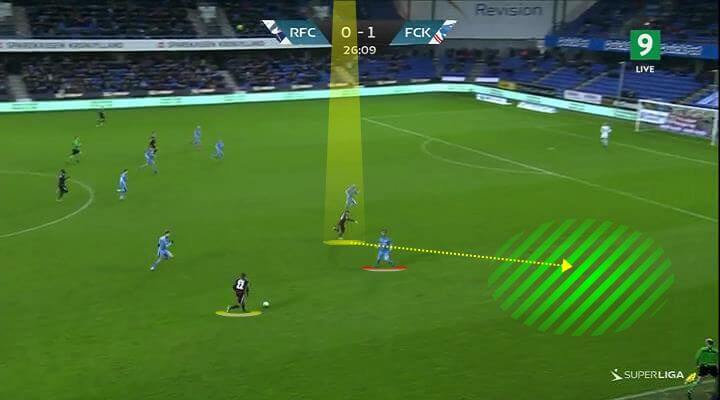
Sometimes when possession is being circulated from left to right, Skov will try to make darting runs beyond the last line of defence. He has the intelligence to time his run effectively, while also possessing sufficient pace to get on the end of a through ball.
As we have seen, the Danish midfielder likes to dominate the interior spaces between the opponent’s left-back and left centre-back. For the most part, the focus of his game in open-play is to receive in front of these two players. However, the next image shows his ability to threaten in behind.
He once again moves on the blind-side of his defensive target, making it difficult for his run to be tracked fully. The ball occupant plays a perfectly weighted through ball, allowing Skov to receive one on one with the goalkeeper, before scoring his team’s third goal against Finland.
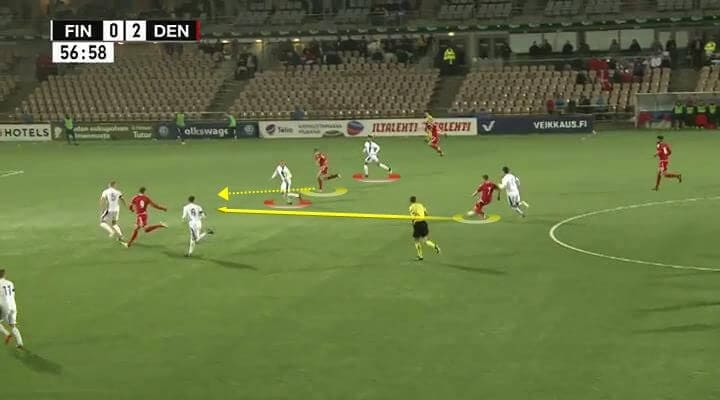
For much of his spell at Copenhagen, Skov was forced to attack against deep defensive units that focused on remaining compact. The Danish side have a number of players capable of operating in tight spaces, as well as playing penetrative passes through narrow gaps in the opponent’s structure.
One of the tactics often used by manager Stale Solbakken saw his midfielders play precise lofted passes over the defensive block for an attacker to receive in the penalty area. Skov was consistently on hand to support these attempts, making late runs off the defender’s shoulders. An example of this can be seen below, as the former Silkeborg youngster gets on the end of a well-executed diagonal ball to score with a first-time finish.
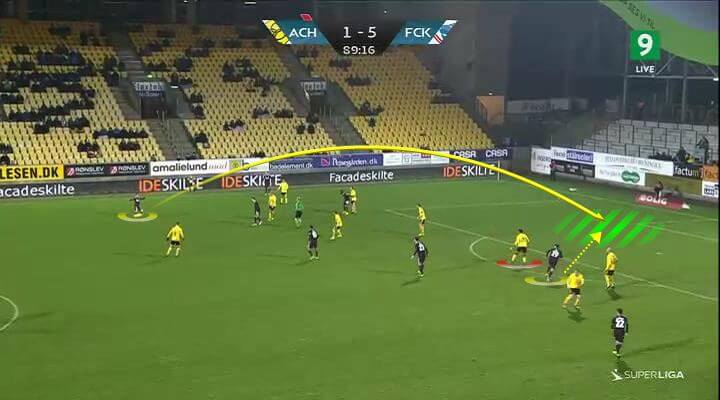
Whether it’s receiving to feet between opposing lines, or making penetrative runs beyond the defence, Skov’s intelligent movement and positional play is a crucial element of his game.
Given that his new boss alters between the 3-5-2, 3-4-1-2 and 3-3-2-2 formations, he is likely to play in a variety of attacking roles this coming season. Based on his skill set, however, a position where he can offer support in central areas, as well as moving out wide on occasion to engage in one v ones, would perhaps suit him best.
Set-piece specialist
Undoubtedly one of the most notable elements of his profile, Skov is remarkable in dead-ball situations. He registered 8 goals from free-kicks last term, while he is also a clinical penalty taker, netting 7 times from 12-yards.
The extent of his goalscoring exploits from free-kicks should strike fear into Bundesliga teams this season, and is representative of his exceptional level of technical control. The first example below highlights this talent, with a perfectly weighted strike looping over the defensive wall and dropping to find the bottom corner of the Odense Boldklub net.
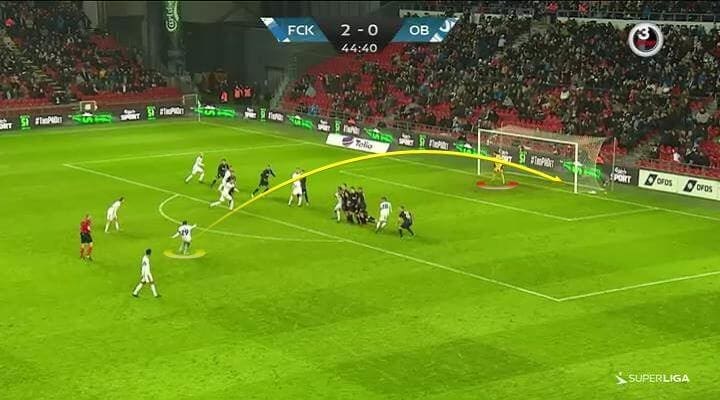
Skov’s free-kick goals have come from a variety of positions, and he is consistently capable of assessing the weight required to overcome the challenge. To emphasise this talent, the image below shows him picking out the top corner from an improbable angle.
Instead of choosing the more obvious option of trying to cross for a teammate, Skov aims for the far corner before driving powerfully beyond the keeper. As the xG map at the end of this section will illustrate, he is confident of shooting from any location within the attacking third, and his confidence is certainly justified.
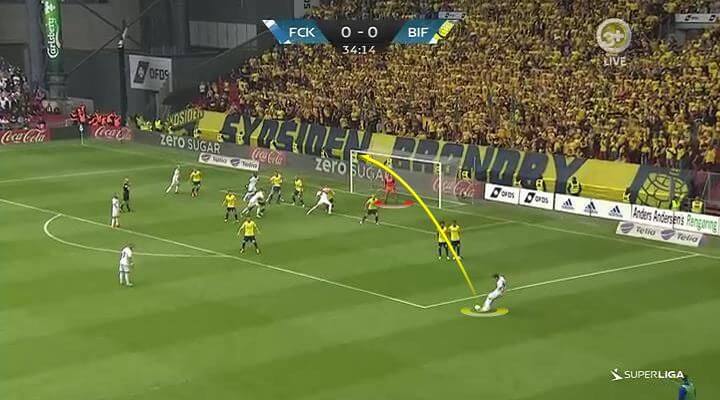
He is also useful from corners, often supplying his teammates with precise deliveries. The next image shows this, with the 6ft 1″ attacker playing an in-swinging cross towards the near post. Dame N’Doye moves in front of his marker to head home, putting the Danish champions ahead against Randers.
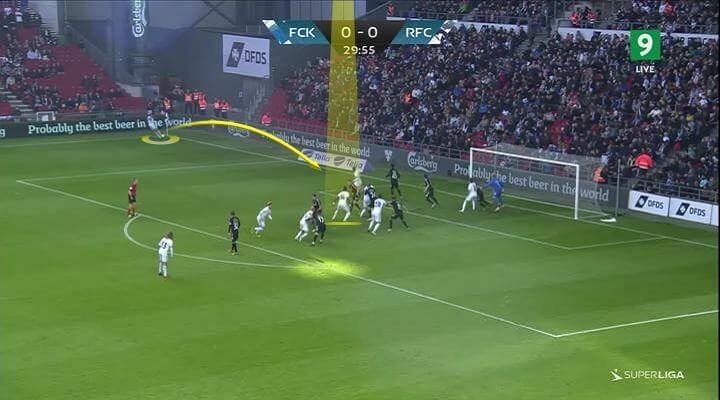
As mentioned, Skov also struck 7 times from penalties last year. His capacity to remain composed under pressure is evidenced by the fact that he only missed one spot-kick. Frequently, he will target one of the top corners, giving the goalkeeper little chance of making a save.
On other occasions, he waits for the keeper’ to make a decision on which side to dive towards, before calmly finishing in the opposite direction. The goal below shows one such instance.
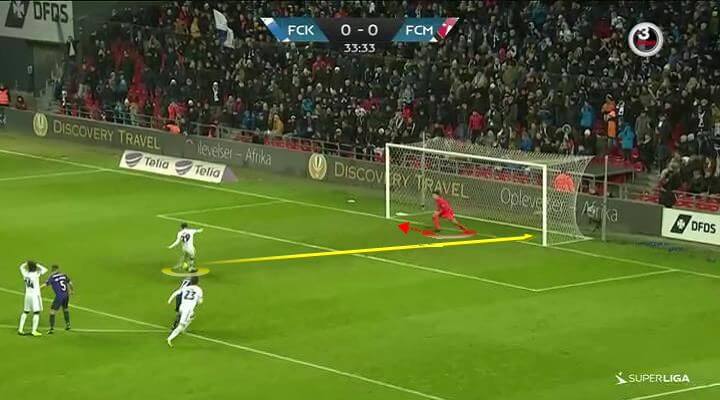
As outlined by this scout report, Skov’s set-piece feats in recent years have been truly exceptional. Only Lionel Messi was able to match his tally of 8 free-kick goals from Europe’s top leagues.
Hoffenheim will no doubt benefit greatly from this talent, and they will be hoping that it can add an extra dimension in their attempts to improve their efficiency in front of goal. TSG scored 70 league goals but underperformed their xG by 9.
Goalscoring from open-play
Far from just being a set-piece specialist, Skov has also displayed the ability to score and assist from open-play. As we saw earlier, his movement patterns are varied, switching between positioning himself in the right half-space, and making runs out wide or in behind.
His default position in the inside right role sees him frequently receive in front of the opponent’s backline on the half-turn. If his attacking teammates are free, he will look to play them through on goal. In circumstances where they are occupied by defenders, Skov will instead attempt shots from outside the box.
In the first example, he has picked up the ball on the edge of the opponent’s penalty area. Backing his technique, he aims for the right top corner. The strike is fired through a crowd of defenders, and the Brondby keeper’ can only watch on as the ball zips past him.
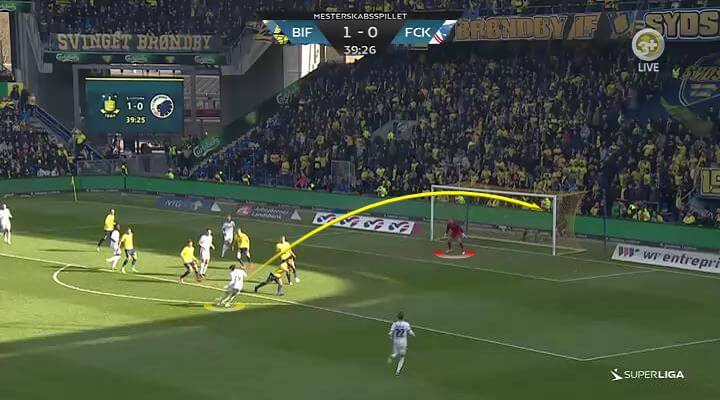
Skov also has a tendency to make late runs into the box when the ball is entering the final third on the far side. He identifies where the space exists to receive a low cross or a cut-back, before arriving at the last second to finish off the move.
This can be seen below, with the Dane moving into a pocket of space in the penalty area as the team’s free man. He receives the ball from the underlapping left-back, finishing with conviction.
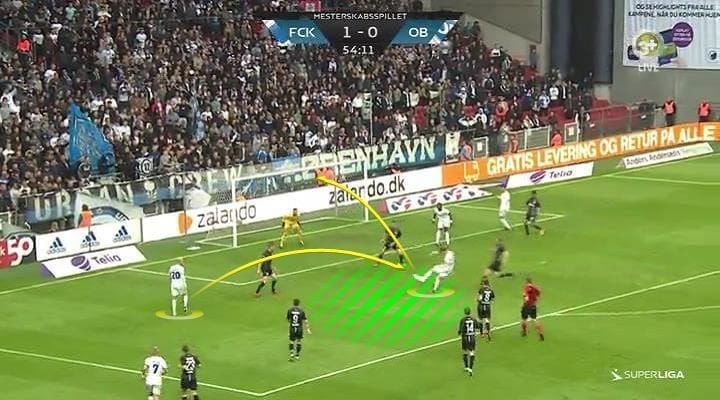
In scenarios where Skov chooses to run in behind, his composure in front of goal is evident once more. We saw earlier how he will sometimes make runs into the space behind opposing fullbacks, as well as in the channel between the left-back and centre-back. Because he tends to arrive in these locations, the shooting angle is often limited.
However, his precise technique and ability to weight attempts appropriately allow him to overcome this difficulty. The goal displayed below provides an example of these types of opportunities, with Skov finding the far corner of the net with little to aim for.
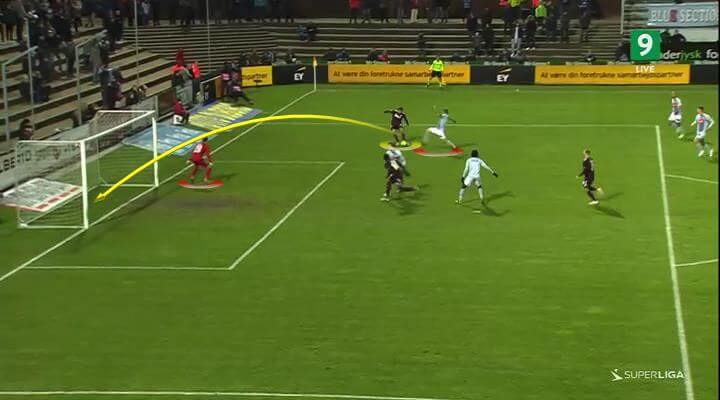
As we have discovered in this analysis, Skov is capable of scoring in a variety of circumstances. If we remove penalties, he still managed to score 22 goals in the league last term. Incredibly his expected goals tally would stand at 9.9, meaning an overperformance of 12.1(shown below).
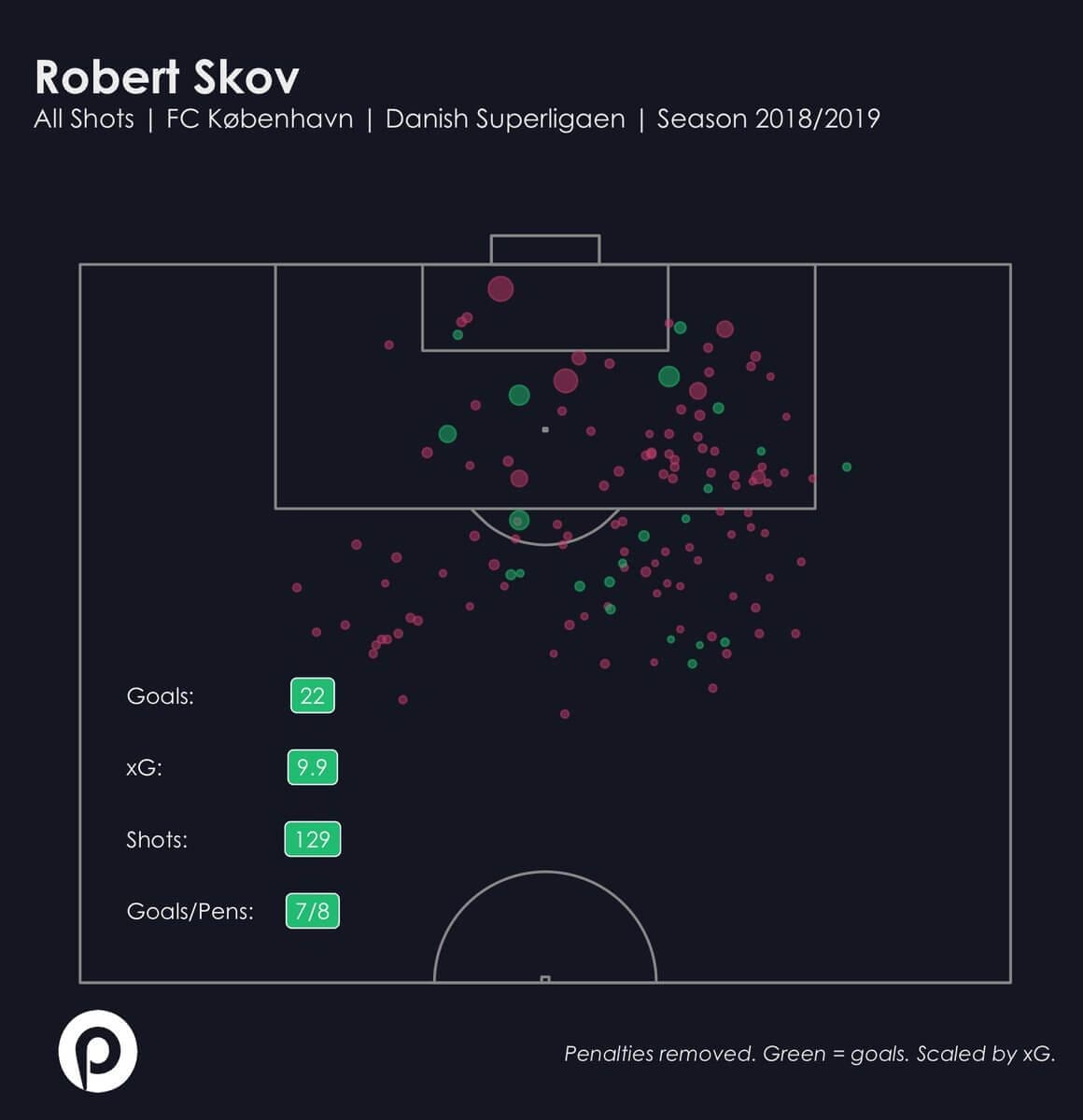
With such a large xG differential, it will be interesting to see how he performs in the Bundesliga. An increase in the quality of opposition is likely to see some regression in terms of output. However, the nature of his goals is also relevant in predicting whether he reverts to a more ‘normal’ xG.
The fact that a large portion of those 22 strikes came from outside the box suggests that scoring from difficult chances will always be a part of his profile as a player. Furthermore, Skov is just 23 and so there is room for continued development and adaptation to a higher level of competition.
Chance creation
Although his reputation has largely been built on scoring goals, Skov also has the qualities required to support his team by creating chances. Last season, he registered 7 league assists, with an xA total of 5.93. He also made 3.44 passes to the box per-game, recording an accuracy rating of 60.2%.
His vision and ability to execute difficult passes through narrow gaps in the opponent’s defensive unit can be seen below. Only one of his attacking teammates in free in this instance, however, there is no clear passing lane through to the player in question.
In order to open this lane, the other forward makes a decoy movement, dragging his marker away from the space. Skov quickly recognises this cue, spotting the free man and finding him with an incisive pass. The recipient went on to score from this sequence, profiting from his teammates’ vision and quick decision making.
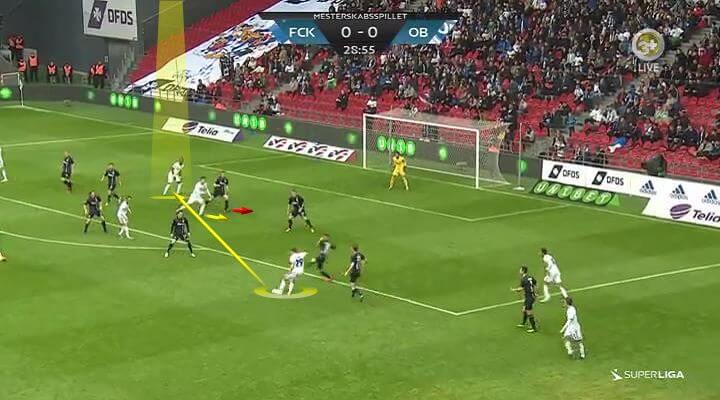
When Skov finds himself with possession on either side of the box, his outstanding technique is equally beneficial. He has the ability to cross off both feet, consistently picking out teammates with well-timed deliveries.
This can be seen below, with the winger targeting the empty space at the far-post. A teammate arrives to finish off the move with a first-time strike. Coupled with the previous example, this illustrates his awareness of where the space is and where the free man is in any given situation.
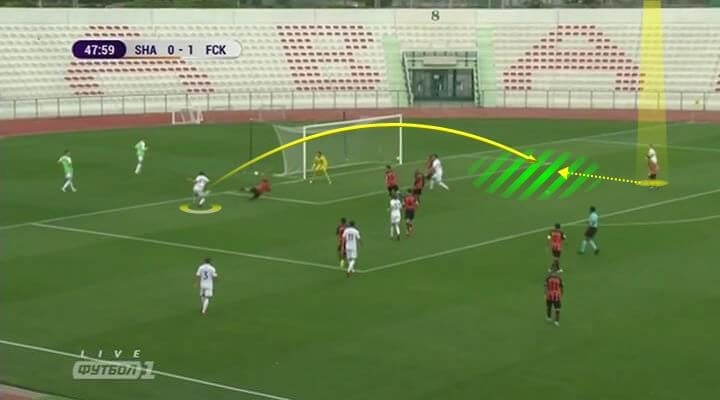
As outlined earlier, Copenhagen are regularly met with low-block defensive systems in the Superliga. This results in limited space behind the opposing back-line, which can restrict Skov’s ability to play through balls for the strikers.
However, he often takes full advantage of any additional space that exists during transitional moments. When his teams embark on a counter-attack, he is adept at playing direct passes beyond the opponent’s back-line. Meanwhile, Skov also looks to exploit this space by recovering second balls when the opposition’s goalkeeper chooses to go long.
An example of this type of assist is shown in the next image, with the attacker playing a first-time ball over the top having won the knock-down from an Austrian goal-kick.
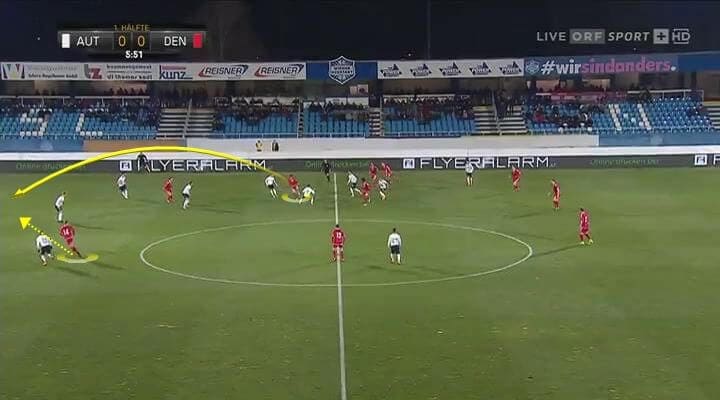
Overall, analysis of the footage and statistics suggest that Skov is capable of creating a significant number of chances for Hoffenheim this season. Additionally, his new side are likely to face a wider variety of defensive strategies than Copenhagen did last term, and so the gifted Dane should have more space to work with.
Ball progression
Adding to the vast array of talents we have already seen, Skov is also an excellent dribbler. His close control, pace and trickery allow him to progress beyond defenders with the ball at his feet. He has the ability to bypass opponents in wide areas before delivering a cross, as well as being able to out-play markers in tight spaces centrally.
In the example below, he drives past a second player having already beaten his first man. Skov recognises where the space exists to progress the play, using his speed to carry the team forward.
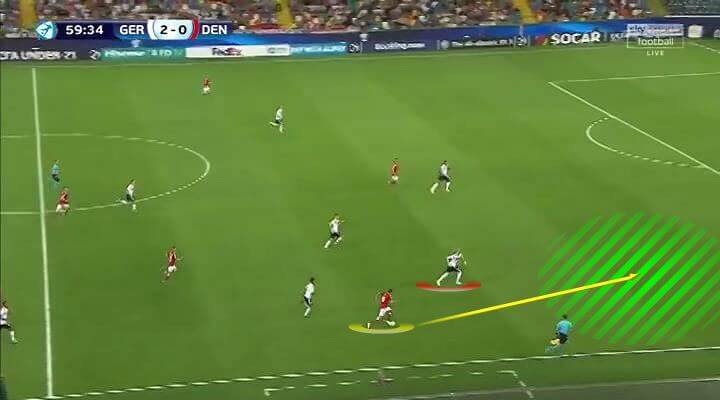
In this instance, he takes the ball towards the byline before delivering a cross to the space on the far side of the box. Notice how the German defence is forced to shift over to the right to cover for the defenders who have been bypassed. This chain effect leaves a Danish player free to receive on the weak side.
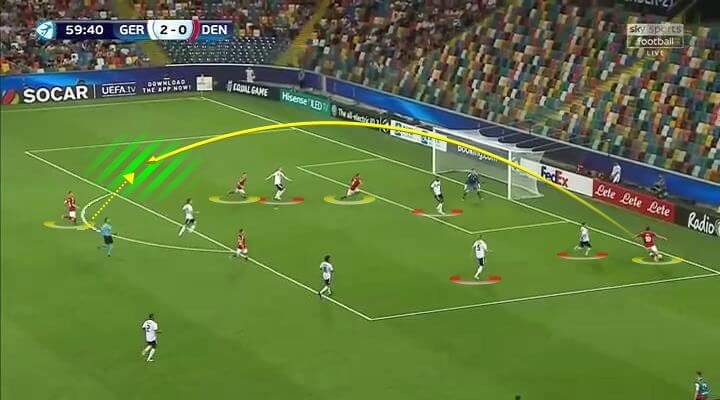
As mentioned, Skov also has the technical quality required to progress via congested central areas. The next move highlights this, with the attacker scanning his surroundings before receiving in the right half-space.
Instead of taking possession on the half-turn, he receives with his back to goal. This triggers the opposing left-back to push up and apply pressure, leaving a hole in the back-line.
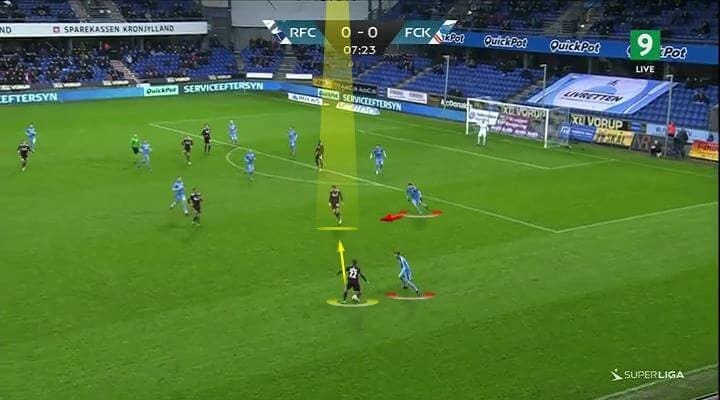
Skov turns just as the ball comes towards him, letting it run across his body and beyond the defenders attempted tackle. With the opponent out of the game, he dribbles into the vacated space on the right of the penalty area before feeding the advancing fullback for a low cross to the back post.
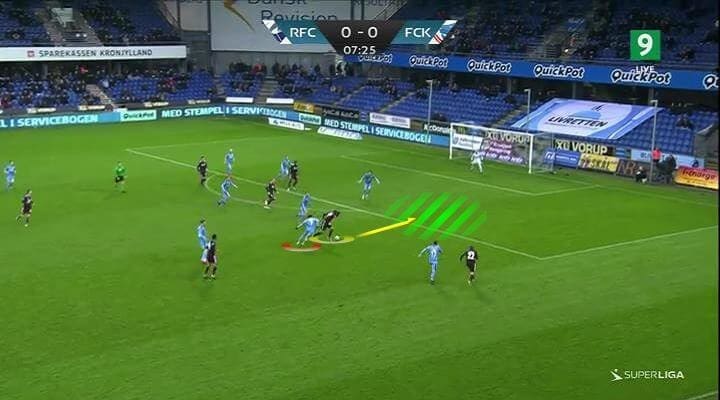
Skov’s ball-progression numbers emphasise how impressive this aspect of his game is. He completed 3.17 progressive runs per 90, categorised as an individual action which advances the ball 10 or more yards in attack, or into the 18-yard box. Meanwhile, he also attempted 7.19 dribbles on average, with a success rate of 48.7%.
Defensive contribution
During the out-of-possession phases, Skov is committed to supporting his defence. His recovery play is impressive, regularly tracking the opponent’s left-back and assisting in completing turnovers down his side. When Copenhagen are established in their defensive phase, he is diligent in his positioning on the right of a midfield four.
Last term, he recorded 5.24 recoveries on average, with 61% coming in the opposition’s half of the field. While many of these will have come from pressing and counterpressing scenarios, Skov’s work ethic can also be seen in chasing back to end the threat of a counter-attack.
The sequence below illustrates this, as Finland look to break and exploit a moment of transition for Denmark. With a number of red shirts ahead of the ball, Skov begins his recovery run.
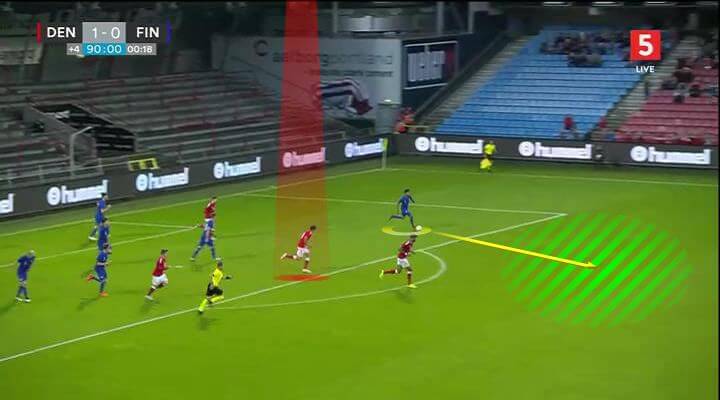
He eventually catches up with the ball-carrier, dispossessing him with a well-timed slide tackle. The Danes then mount a counter-attack of their own, with Skov returning to his feet and supporting the play with an overlapping run out wide.
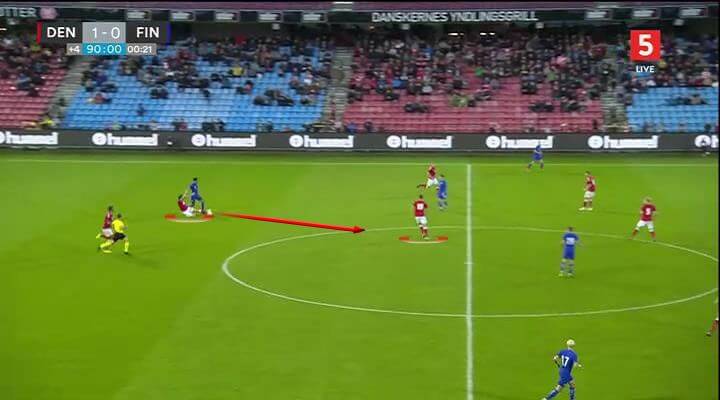
Along with his capacity to react well to dangerous situations, he is also able to defend proactively. Skov is intelligent when applying pressure, angling his approach to shut-off any short-passing options and force the ball-occupant to play hopeful long passes.
Furthermore, he has the ability to read the opponent’s intentions, moving into position to intercept attempted passes. The final example highlights this, as he cuts out a dangerous ball towards the advanced left-wing.
He had previously been applying a cover shadow to prevent passes into the feet of the opposing left-back, but adjusted his positioning at the last second as the player on the ball shaped to play vertically instead. His average interception total last term was 3.05.
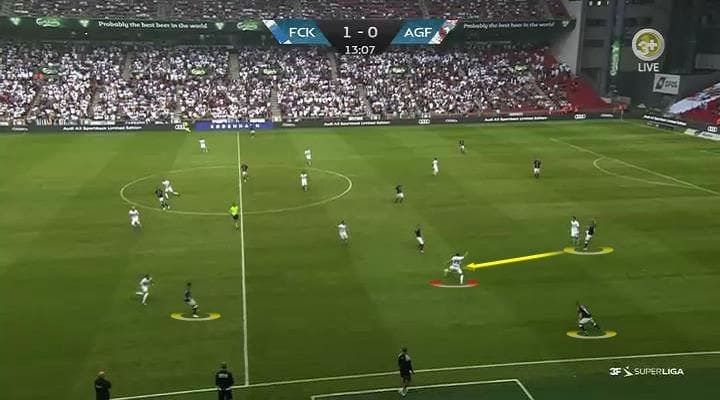
So far in his career, Skov has been able to balance his exceptional attacking output with discipline out of possession. At Hoffenheim, he will be expected to press high at times, and his understanding of when to apply pressure and how to angle his approach will no doubt please Schreuder.
Conclusion
Given the difference in standards between the Danish Superliga and the German Bundesliga, Skov may take some time to fully adapt. However, his talent is undeniable and at 23, he still has plenty of time to grow into a top-level star. Should he continue to develop at the rate he has shown so far, a regular spot in the national team should be forthcoming. Despite the relatively small price tag, don’t be surprised to see Robert Skov become a household name this season.

If you love tactical analysis, then you’ll love the digital magazines from totalfootballanalysis.com – a guaranteed 100+ pages of pure tactical analysis covering topics from the Premier League, Serie A, La Liga, Bundesliga and many, many more. Buy your copy of the August issue for just ₤4.99 here.

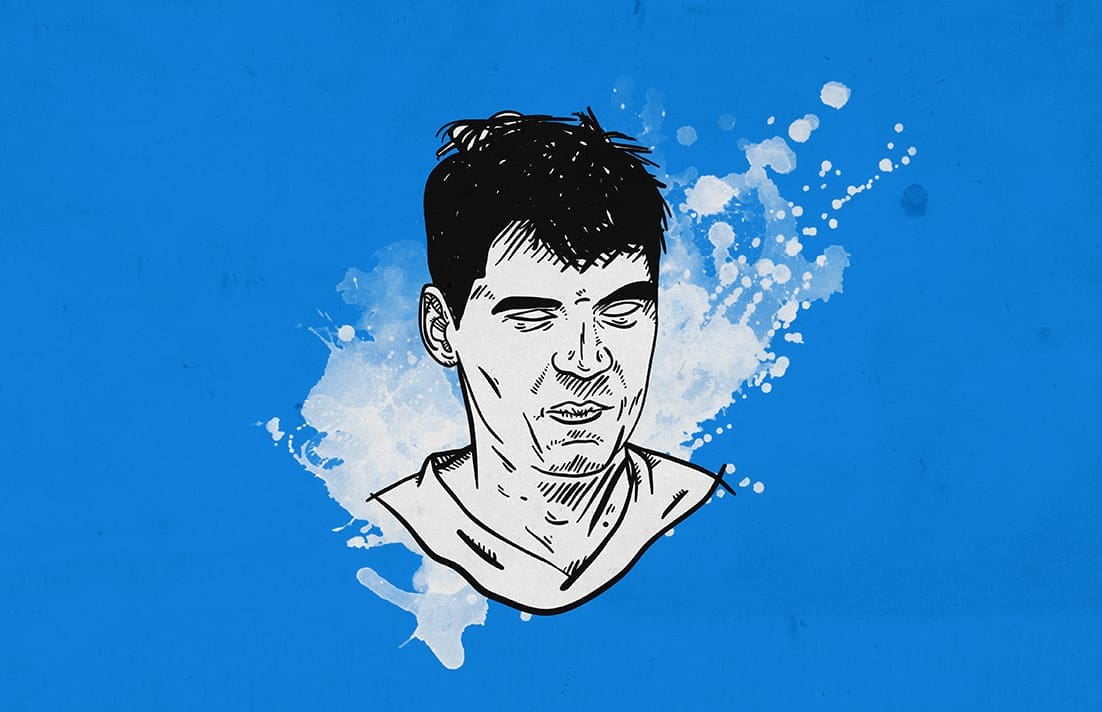




Comments